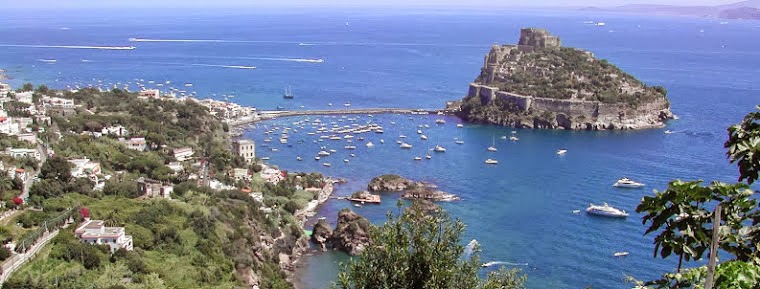Ischia is the largest island in the bay of Naples and is considered by many to be the most beautiful, (though Capri is considerably more famous). The island is 10 km from east to west and 7 km north to south. It has a coastline of 34 km and covers an area of 46.3 sq km. It has a permanent population of approximately 58,000. Up to 6 million tourists (principally from the Italian mainland and Germany) flock to the island for its volcanic thermal spas and as well for its beaches and food.
Several towns are located along the island's coast. The largest city in Ischia is actually (and often confusingly, for tourists) called Ischia. The town of Ischia, however, has two different centers: Ischia Porto and Ischia Ponte. Ischia Porto is the commercial center of the island and is named after the main port. Ischia Ponte ("ponte" meaning "bridge" in Italian) is named for the area surrounding and including the footbridge that was constructed to connect the Castello Aragonese with the island. Beside the town of Ischia, some of the other centres are Lacco Ameno, Casamicciola, Forio, Barano, Sant'Angelo, and the jointed town of Serrara-Fontana.

Ischia — historically called Pitecusae — has been colonized in turn by the Greeks, Syrausansa, Romans, Saracens, Turks, and Aragonese; all of whom were interested in its excellent strategic position as well as its therapeutic hot-spring waters and of course its attractive landscape. The result of all this varied history can be seen in the ruins of various outposts, towers, and "tufa" rock shelters hidden all over the island.
More recently Ischia has become a frequent backdrop for Italian and American movies such as “Vacanze ad Ischia”, “Appuntamento ad Ischia”, and "The Talented Mr.Ripley". The island has also been used as a cinematic stand-in for the Island of Capri.
Climate
The best time for the traveler to visit Ischia is from April to October, however, the weather in Ischia is always changing and visitors should expect both sunshine and rain — whatever the season. Summer, the main tourist season, combines long, hot days with lengthy evenings. Winter can be bitterly cold and wet, with short daylight hours.

Flora and fauna
Also called the "Green Island", Ischia enjoys hot and dry summers and mild winters along with a pronounced fertility which is a result of having almost an entirely volcanic soil. These factors allow Mediterranean plants to thrive all over the island, and sub-tropical and tropical species to successfully occupy niches in the warmest areas.

On the Southern side of the island, the continuous exposure to direct sunlight favors tropical and desert vegetation which is mainly represented by palms, cactus' and agave plants with Mediterranean trees hiding in the shade of inlets and bends. On the Northern side of the island in the shade cast by Mount Epomeo, you'll find chestnut trees, as well as typical Mediterranean trees such as the holm oak, cypress, and cork trees as well as cultivated almond trees, vines, and olive trees.

Ischia Mud
Ischia mud originates from the geologic evolution of the island where, over the centuries, many hydrovolcanic eruptions and earthquakes changed the soil composition. The hot waters and muds, all “thermal” or “hypertermal” i.e. they are at the same time hot or very hot and very rich in minerals content. In spite of their diversity, all the muds have the same standard features: sodium, chlorine, potassium, calcium and sulphur in the form of sulphates and sulphides. Because of the variety of different chemicals found in them, different waters and mud are recommended for different treatments.

The Italian Ministry of Health produces a document that has updates on which waters and muds are suitable for therapeutic treatments and illness and diseases which can be treated. According to this document, disease which can be treated are: rheumatic diseases such as arthrosis; respiratory diseases; dermatological diseases such as psoriasis, atopical dermatitis, eczema (except for exudative bladdery forms), chronic seborrhea; gynecological diseases such as pelvis tissue sclerosis; diseases of the gastroenteric apparatus such as gastroenteric or bilious dyspepsia, and intestinal disorders associated with constipation.

Cavascura and Olmitello Thermal water
While traveling around Sant’Angelo there are several footpaths that can take you up the hilltops. One of these is a footpath that goes to the thermal springs of Cavascura and Olmitello. To get there, take a taxi boat from the square of Sant’Angelo to the Fumarole beach. Here, with the beach behind you, take the footpath from the right side of the beach which is flanked by oleander trees. The first stretch is steep, with a few houses on both sides, then it levels out and there are Mediterranean bushes and a variety of plants such as figs, capers, prickly pears, etc. On the right, there is a view of the Maronti beach.
Passing under a natural arch, turn right to reach the beach. Here is the entrance to Cavascura. There are all types of typical restaurants and at the back of the canyon are the antique thermal springs of Cavascura. Going back, climbing the steps through the vine yards, you will arrive at the antique establishment of Cava Olmitello, which sadly to say is in disuse. Here, as you make your way through the bushes, with only the croaking of frogs, you can imagine yourself traveling back in time when the world was a much simpler place.










No comments:
Post a Comment